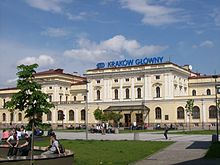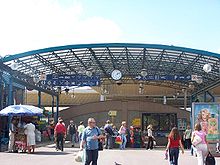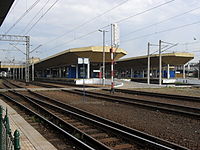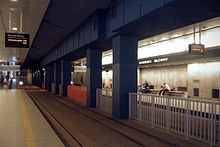- Transport in Kraków
-
Transport in Kraków is based around a fairly dense network of tramway and bus lines operated by a municipal company, supplemented by a number of private minibus operators. Local trains connect some of the suburbs. The bulk of the city’s historic area has been turned into a pedestrian zone with golf buggies, rickshaws and horse buggies; however, the tramlines run within a three-block radius.[1] Rail connections are available to most Polish cities. Trains to Warsaw depart every hour. International destinations include Berlin, Budapest, Prague, Hamburg, Lviv, Kiev, and Odessa (June–September).[2] The main railway station is located just outside the Old Town District and is well-served by public transport.
There is an international airport 11 km (7 mi) west of the city. Direct trains cover the route between the main railway station and the airport in 18 minutes.
Contents
International Airport
Main article: John Paul II International Airport Kraków-BaliceKraków's airport, (John Paul II International Airport Kraków-Balice, Polish: Międzynarodowy Port Lotniczy im. Jana Pawła II Kraków-Balice) is 11 km (7 mi) west of the city. Direct trains cover the route between Kraków Main station and the airport in 16 minutes, but the service is unreliable because the railway track into the airport is an old military line that has not been upgraded. The annual capacity of the airport is estimated at 1.3 million passengers; however, in 2007 more than 3.042 million people used the airport, giving Kraków Airport 15 percent of all air passenger traffic in Poland. The passenger terminal is undergoing extension and is being adapted to meet the requirements of the Schengen Treaty.[3]
Kraków Central station
Main article: Kraków Main stationKraków Central station (Polish: Kraków Główny, commonly called Dworzec Główny) is the largest and the most centrally located railway station in Kraków. The building, constructed between 1844 and 1847 (architect: P.Rosenbaum), is parallel to the tracks. The station was initially a terminus of the Kraków – Upper Silesia Railway (Kolej Krakowsko-Górnośląska, German: Obeschlesische-Krakauer Eisenbahn). The design was chosen to allow for future line expansion. Trains entered the trainshed via an archway in a brick wall at the northern end of the station.
The station opened on 13 October, 1847, with the first train leaving for Mysłowice (the point where the Austrian, German and Russian Empires adjoined during their military partitions of Poland).
When the railway line got extended eastwards by the k.k. priv. galizische Carl Ludwig-Bahn (the first section, to Dębica, then Dembitz in the Habsburg Empire, opened in 1856). The increasing traffic resulted in the station's having been modernised and enlarged in stages between 1869 and 1894. The next substantial expansion took place in the 1930s. At that time the northern brick wall and trainshed were demolished, the latter replaced by individual platform roofs.
A new transport interchange was developed which included a coach station and an express tram line. A new shopping centre (Galeria Krakowska, Kraków Gallery) opened in September 2006. The construction of the Galeria Krakowska and remodelling of the area in front of the main station building means that taxis are no longer able to drive up to the station, or to collect passengers directly from the station.
Tram system
Main article: Tramways in KrakówThe Kraków Fast Tram system, KST (Polish Krakowski Szybki Tramwaj) is a premetro/tram system connecting northern and southern parts of the city. Currently two lines of KST are in operation. Line 50 operates between Kurdwanów in the district of Podgórze Duchackie which is south of Vistula River, and Krowodrza Górka in Krowodrza, north of the river. Line 51 operates between Dworzec Towarowy and Bieżanów Nowy in the south east district of Bieżanów.
Works on an underground tunnel for trams in the main railway station area started in 1974 and the 1.538 kilometer-long tunnel was finally opened on 12 December 2008.
Dworzec Główny Tunnel is an underground station directly connected to the platforms of the main railway station and to the Galeria Krakowska shopping mall.[4]
Politechnika is an underground station located near the campus of the Cracow University of Technology.[5]
In July 2010, MPK placed an order with Bombardier for a further 24 Flexity Classic trams.[6]
References
- ^ Marek Strzala, "Krakow. Varied Means of Transportation". http://www.krakow-info.com/transpor.htm. Retrieved 2007-05-12.
- ^ (Polish) Magiczny Kraków, city's official website. "International railway connections from Krakow". Archived from the original on 2007-10-13. http://web.archive.org/web/20071013123132/http://www.krakow.pl/turystyka/?id=praktyczne/12.html. Retrieved 2007-09-15.
- ^ World Airports Guide. "Kraków Airport". Archived from the original on 2007-12-19. http://web.archive.org/web/20071219112238/http://www.azworldairports.com/cfm/frame.cfm?src=http://www.azworldairports.com/airports/p2310krk.htm. Retrieved 2007-05-12.
- ^ Panoramic view of the Dworzec Główny Tunel station
- ^ Panoramic view of the Politechnika station
- ^ "Railway Gazette: Kraków orders 24 Flexity trams". http://www.railwaygazette.com/news/single-view/view/10/krakow-orders-24-flexity-trams.html. Retrieved 2010-07-23.
Bibliography
- Encyklopedia Krakowa. Warszawa-Kraków: Wydawnictwo Naukowe PWN. 2000.
- Demel, Juliusz (1954). Początki kolei żelaznej w Krakowie. Towarzystwo Miłosników Historii i Zabytków Krakowa.
- Station history at Magiczny Kraków, the city's official webpage
External links
 Media related to Main Train Station in Kraków at Wikimedia Commons
Media related to Main Train Station in Kraków at Wikimedia Commons- mpk.krakow.pl Miejskie Przedsiębiorstwo Komunikacyjne SA w Krakowie
- krakow-info.com Getting around in Krakow
Categories:
Wikimedia Foundation. 2010.





